The Johnson County Fair: A Rich Historic Tradition
Return to agent articles.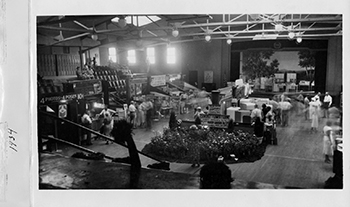 Growing up in Hutchinson, Kan, I always loved my family’s yearly visit to the State Fair. Each year, the excitement began with the arrival of the fair train, which could be seen from the classrooms at my grade school. The teachers, recognizing a losing battle, would suspend teaching to allow the roomful of squealing kids to rush to the windows to watch the colorfully decorated train pass.
Growing up in Hutchinson, Kan, I always loved my family’s yearly visit to the State Fair. Each year, the excitement began with the arrival of the fair train, which could be seen from the classrooms at my grade school. The teachers, recognizing a losing battle, would suspend teaching to allow the roomful of squealing kids to rush to the windows to watch the colorfully decorated train pass.
My family had an established routine for touring the fair. Each year, we entered the fairgrounds near the livestock buildings and would slowly proceed through each building, admiring first the horses, then cows, followed by the pigs, rabbits and then poultry. We would make our way over to the Agriculture Building to view the cascading fountain of wheat, displays of beautifully arranged produce, and exclaim over the largest pumpkin and watermelon winners. Our Ag Building tour always included a stop at the Butter Cow.
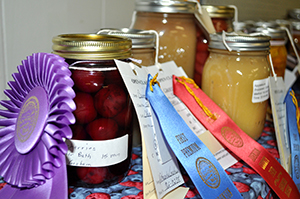 The colorful Domestic Arts Building with its cookies and cakes, and jewel-like jellies and jams glimmered before my eyes. The sights, smells, and familial routine of the State Fair were impressed on my young brain. Over the years, I grew to appreciate the beauty and dignity of rural life that exhibitors from around the state displayed during the hot waning summer days of September.
The colorful Domestic Arts Building with its cookies and cakes, and jewel-like jellies and jams glimmered before my eyes. The sights, smells, and familial routine of the State Fair were impressed on my young brain. Over the years, I grew to appreciate the beauty and dignity of rural life that exhibitors from around the state displayed during the hot waning summer days of September.
My appreciation for Kansas’ fair grew even more during my eighteen year residence in Texas, where I quickly discovered that not all State Fairs were the same.
It wasn’t until my return to Kansas and my joining the staff at the K-State Research and Extension office in Johnson County that I began to learn about fairs at the county level and the importance they play in the success of the State Fair. County fairs, with all the hard work and preparation that goes into them, form the backbone of the State Fair. Like most people, I assumed that the Johnson County Fair had always been held at the fairgrounds in Gardner. But a little digging revealed that Johnson County has a rich history ripe with a competitive, entrepreneurial spirit.
Fairs: useful tools for promoting agriculture and attracting new residents 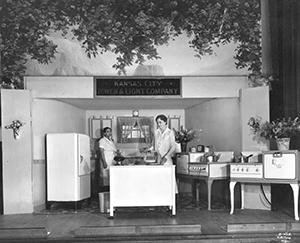 Most fairs between 1855 and 1900 were privately funded by agriculture societies with the intention of promoting scientific livestock breeding. In addition, the State Board of Agriculture saw fairs as an avenue for promoting the state’s rich resources for farming and industry. The Board encouraged the creation of fairs as a way to attract settlers and immigrants to the state.
Most fairs between 1855 and 1900 were privately funded by agriculture societies with the intention of promoting scientific livestock breeding. In addition, the State Board of Agriculture saw fairs as an avenue for promoting the state’s rich resources for farming and industry. The Board encouraged the creation of fairs as a way to attract settlers and immigrants to the state.
County businesses responded by building fairgrounds with permanent buildings. To pay their expenses however, fair associations incorporated horse races, circuses, curiosity shows and any other form of entertainment that would draw large crowds. Soon, the agriculture aspect took a back seat as the primary focus of these fairs.
Johnson County's competing fairs: Gardner VS Olathe VS Edgerton
Kansas’ first county fair was held in 1858 in McCamish, north of Edgerton. It wasn’t until the Civil War ended that a fair would return to the county. Gardner held a fair in 1865, which included agriculture, industrial and domestic exhibits. Olathe held similar fairs from 1867 through the 1870s, thus beginning a competition between the two cities that ran through the 1930s.
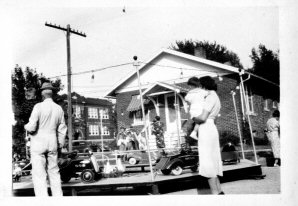 Cooperative organizations established by farmers in the 1880s began to play a large role in county fairs. In Johnson County, farmers organized local branches of the Patrons of Husbandry, which was known simply as the Grange. The Olathe Cooperative was formed in 1884 and boasted a membership of 1,026. The Johnson County Cooperative Fair Association appeared in the 1880s and 1890s, holding their fair repeatedly in Edgerton, with a focus on “clean” entertainment, eliminating gambling and seedy midway shows. Pony races, mule races, ladies bicycle races, tug of wars and baby contests were some of the more family friendly entertainment held during the years. Olathe again was the site for a fair in 1893. The Johnson County Fair Association sponsored Olathe’s fairs during the 1890s, holding them after Edgerton’s fair.
Cooperative organizations established by farmers in the 1880s began to play a large role in county fairs. In Johnson County, farmers organized local branches of the Patrons of Husbandry, which was known simply as the Grange. The Olathe Cooperative was formed in 1884 and boasted a membership of 1,026. The Johnson County Cooperative Fair Association appeared in the 1880s and 1890s, holding their fair repeatedly in Edgerton, with a focus on “clean” entertainment, eliminating gambling and seedy midway shows. Pony races, mule races, ladies bicycle races, tug of wars and baby contests were some of the more family friendly entertainment held during the years. Olathe again was the site for a fair in 1893. The Johnson County Fair Association sponsored Olathe’s fairs during the 1890s, holding them after Edgerton’s fair.
Cooperative Extension Service begins in 1917 and supports county fairs 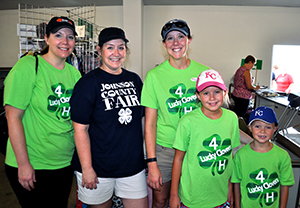 Farm Bureaus and County Extension Services were established throughout the country in response to the 1917 Smith-Lever Act, which recognized the importance of farming and its contribution to the country during World War I. The Extension Service began to provide farmers with scientific information in an effort to help improve their operations and increase their stability.
Farm Bureaus and County Extension Services were established throughout the country in response to the 1917 Smith-Lever Act, which recognized the importance of farming and its contribution to the country during World War I. The Extension Service began to provide farmers with scientific information in an effort to help improve their operations and increase their stability.
Extension also began supporting county fairs, promoting participation by local farmers, thus returning the fair’s emphasis back to an agricultural theme.
After World War I county fair bounces around the county and competition between the cities heats up 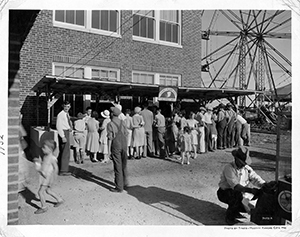 Johnson County saw a boom in community fairs after World War I. The Grange sponsored fairs in Spring Hill during 1917 and 1918. Olathe held fairs in 1919, 1920 and 1923, moving it to a different location with each new year.
Johnson County saw a boom in community fairs after World War I. The Grange sponsored fairs in Spring Hill during 1917 and 1918. Olathe held fairs in 1919, 1920 and 1923, moving it to a different location with each new year.
In order to attract residents in the northern reaches of the county, another fair association was formed. Their first fair, called the Farm, Home and School Festival, was held in Merriam in 1922. By 1927, the name had changed to the Johnson County Shawnee Mission Fair and was held through 1931 at the old Shawnee Mission Rural High School. In direct competition, Olathe continued to offer their summer fair as well.
During the 1930s, fairs popped up all across the county. Gardner continued to have a fair from 1931 to 1936 before moving it to Spring Hill in 1938. Overland Park sponsored a fair from 1934 to 1938. In 1937, Olathe moved their fair to the Nafziger Farm at 83rd and Mission in an attempt to increase attendance and northern county residents’ interest in agriculture. To “attract countywide interest and respect for the community,” organizers hired nationally known trick riders and horsemen. The effort failed to produce the desired results and Olathe did not sponsor a fair the following year.
In 1939, the county fair, as we now know it, began to coalesce. The Spring Hill 4-H and Gardner Community fairs were combined and called the Johnson County Fair. In 1940, Gardner became the home for the Johnson County Free Fair. Gardner continues to this day to be the official host city for the Johnson County Fair.
After WWII Extension works with communities to clean up fairs and introduce 4-H Youth Development 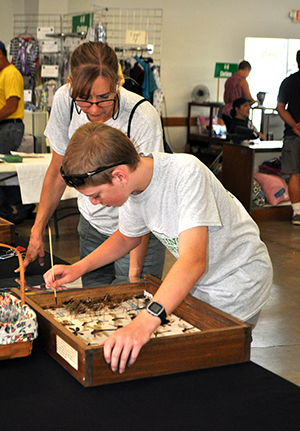 Fairs experienced a second boom following World War II. Communities began to increasingly influence fairs, pushing to get rid of unsuitable entertainment, and encourage youth education and participation.
Fairs experienced a second boom following World War II. Communities began to increasingly influence fairs, pushing to get rid of unsuitable entertainment, and encourage youth education and participation.
Extension agents began working with 4-H youth clubs in an effort to percolate university research-based farming information to doubting parents. By the 1950s, involvement of local 4-H youth and their parents were vital to the success of a county fair. As more 4-H clubs got involved, community participation increased as well.
Funding the county fair
Permanent fairgrounds and structures were increasingly funded using local tax dollars, but public support in Johnson County was difficult to obtain. Several levies had been defeated due to lack of support by northern residents. L. H. “Bing” Carter, fair general manager and a member of the Johnson County Fair Association, incorporated the help of Jan Meyers, president of the Johnson County League of Women Voters. By emphasizing the benefits of youth education in 4-H competitions, Meyers and the League agreed to Carter’s request for help, successfully campaigning for a mill levy, which was passed in the mid-1970s. Because of their efforts, the Johnson County Fair remains a strong and viable operation. To this day, admission into the fair is free.
Johnson County’s explosive population growth during the past decades has pushed it to become increasingly suburban in nature. With this major cultural shift, the Johnson County Fair continues to change with the times.
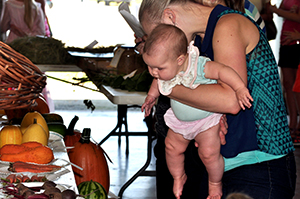 More than 100,000 visitors attend the fair, held annually the first week of August. While agriculture continues to be an important element with its 4-H livestock competitions, exhibits and auctions, 4-H is following societal trends.
More than 100,000 visitors attend the fair, held annually the first week of August. While agriculture continues to be an important element with its 4-H livestock competitions, exhibits and auctions, 4-H is following societal trends.
Although originally founded to supplement educational opportunities for rural youth, contemporary 4-H youth development focuses on helping young people build life skills that will help them interact as responsive citizens in a global society. This urban shift can be in seen in the increase of 4-H projects in computer technology, aerospace and rocketry, entomology, forestry and photography. This year, over 7,000 exhibits will be on display in 41 departments. 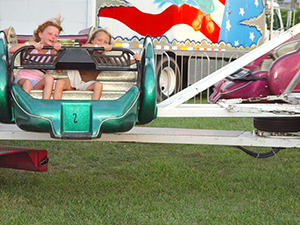 To make this 21st century suburban county fair work, it now takes the efforts of more than 300 volunteers. Carnival rides, live music and food stands continue to be a large attraction. The Fair Board works hard to provide numerous avenues for free entertainment.
To make this 21st century suburban county fair work, it now takes the efforts of more than 300 volunteers. Carnival rides, live music and food stands continue to be a large attraction. The Fair Board works hard to provide numerous avenues for free entertainment.
With its roots steeped in the rural past, the Johnson County Fair has evolved into a suburban affair. Yet, it remains a popular family excursion.
When I tour the grounds, visiting the livestock exhibits, breathing the barnyard aromas mixed with the sticky sweet scent of cotton candy wafting on the breeze, I am transported back to my childhood. As I experience the joyful symphony of sights, sounds and smells, all seems safe in the world. While the exhibits and entertainment continue to change as society changes, the Johnson County Fair is still a wonderful celebration of our agricultural heritage and strong sense of community.